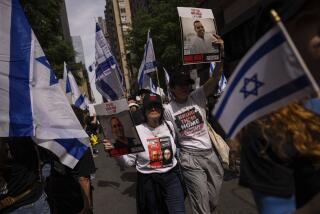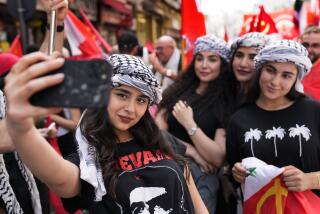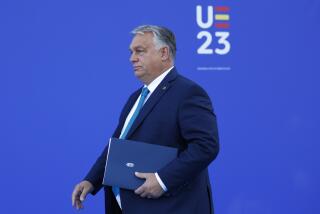Western Envoys at 1st Soviet May Day Parade Since ’79
- Share via
MOSCOW — Tens of thousands of Soviet workers paraded through Red Square on Sunday in celebration of May Day, an annual rite of spring that was attended by Western ambassadors for the first time since the 1979 Soviet invasion of Afghanistan.
The full Kremlin leadership appeared atop V. I. Lenin’s mausoleum outside the Kremlin, giving no clue to the rumored power struggle taking place between Soviet leader Mikhail S. Gorbachev and Yegor K. Ligachev, the No. 2 official in the ruling Politburo.
Gorbachev chatted for several minutes with Ligachev, the Communist Party official in charge of ideology. There has been persistent speculation that they had clashed over the pace of Gorbachev’s reform program.
The May Day festivities, which officially mark a day of international worker solidarity, were also attended by a large contingent of ambassadors from the United States and Western Europe.
The envoys have stayed away from the annual parades as a gesture of protest at the continued presence of Soviet troops in Afghanistan. The diplomats’ return was prompted by the peace agreement signed last month in Geneva under which the Soviets will begin to withdraw its estimated 115,000 troops from the country begining later this month.
“I considered it appropriate to resume attending these meetings,” U.S. Ambassador Jack F. Matlock Jr. told reporters in Red Square. He added that his presence was also designed as a gesture of American-Soviet good will a month before the scheduled summit meeting in Moscow between Gorbachev and President Reagan.
The British ambassador to the Soviet Union, Bryan Cartledge, also called the Soviets’ Afghan move “a step in the right direction.” But he said he is undecided yet whether he will attend the annual military parade through Red Square that takes place every Nov. 7, the anniversary of the Bolshevik Revolution.
The May Day celebrations are generally festive affairs. Thousands of Soviets parade in most cities, accompanied by displays of athletic prowess and floats with revolutionary slogans.
One float in this year’s parade portrayed bureaucrats attempting to slow down the pace of Gorbachev’s program of reforms, which the Soviets refer to as perestroika, or restructuring.
In recent months, the Soviet media have published detailed accounts of resistance to the reform program but have shed no light on the power struggle reported to be taking place in the Kremlin.
On Saturday, one Soviet newspaper published a letter that purported to be a popular expression of concern that Gorbachev might be ousted from office as Communist Party leader before being able to complete the reform program. The letter said, however, that Gorbachev was supported by a majority.
An editorial in Pravda, the Communist Party newspaper, said Sunday that the course embarked upon when Gorbachev took power in 1985 now seems clearly warranted.
“The course chosen by the party meets the requirements of life,” the newspaper said.
Elsewhere, the holiday prompted Pope John Paul II to condemn unemployment as a major social evil, while violence flared in Chile, the Philippines and South Korea.
Speaking in Civta Castellana, north of Rome, the pontiff told local workers that the “laws of profit” or economic policies cannot be used to justify an evil “that prevented men from earning an honest living and from participating fully in society.”
In Chile, police shot and wounded three people taking part in May Day protests against the government of President Augusto Pinochet. More than 130 people were arrested.
Opposition labor unions have called for a general strike starting May 11 to demand more than a doubling of the minimum monthly wage, currently about $46.
At least two people were injured when riot troops opened fire on a May Day march in Calamba, 30 miles south of Manila. The gunfire erupted when the marchers refused a police order to disperse.
In Manila, 15,000 to 20,000 people marched to back demands for pay increases.
In Seoul, thousands of South Koreans marched to protest government policies.
More to Read
Sign up for Essential California
The most important California stories and recommendations in your inbox every morning.
You may occasionally receive promotional content from the Los Angeles Times.










